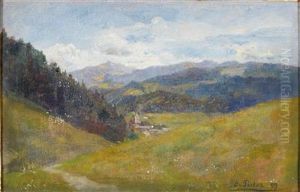Oskar Ritter V. Pistor Paintings
Oskar Ritter von Pistor was an Austrian painter known for his involvement in the Viennese Secession movement and his contribution to the development of modern art in Austria at the turn of the 20th century. He was born in 1873 in Vienna, Austria, into an era when the city was a vibrant center of art and culture.
Von Pistor's artistic journey began at the Academy of Fine Arts Vienna, where he studied under renowned artists such as Christian Griepenkerl and Siegmund L’Allemand. His early work was influenced by the academic style of painting, but he soon found himself drawn to the more progressive and avant-garde movements that were emerging in Vienna at the time.
As a contemporary of Gustav Klimt and Egon Schiele, von Pistor was exposed to the radical ideas that were challenging traditional art forms. He became an active member of the Viennese Secession, a group of artists who broke away from the conservative Künstlerhaus to create their own exhibition space and promote individualistic and modern approaches to art.
Von Pistor's work during this period reflected the Secession’s emphasis on decorative arts and the integration of fine art with architecture and design. His paintings often featured stylized, ornamental elements and a bold use of color, which became characteristic of the Secessionist style. He also participated in collaborative projects, contributing to the artistic decoration of public and private buildings, which was a key objective of the movement.
Despite his involvement with the Secession, von Pistor also maintained an individualistic approach to his art. He explored various subjects, including landscapes, portraits, and allegorical scenes, always seeking to express his own vision rather than adhere strictly to the collective ethos of the group.
Oskar Ritter von Pistor's career was cut short when he passed away in 1929. Though his name may not be as widely recognized as some of his contemporaries, his work remains an important part of the narrative of Austrian art history. It provides insight into the transitional period between 19th-century academic art and the modernist movements that would redefine the visual arts in the 20th century.
